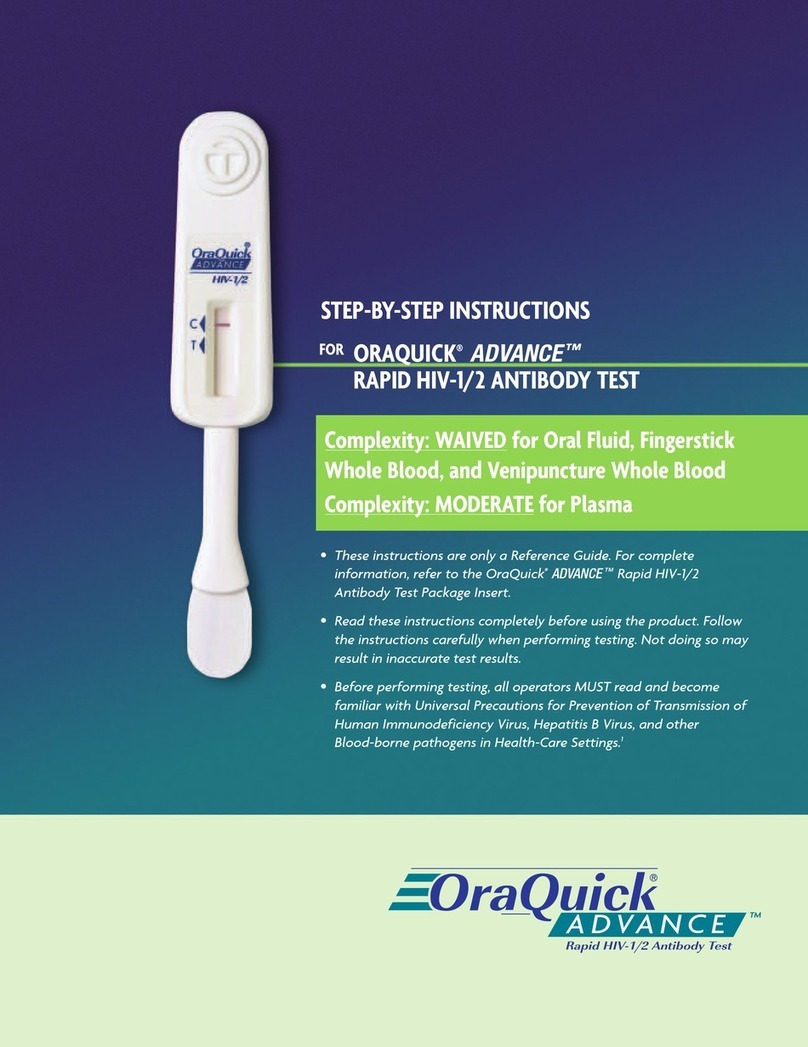
SE REQUIEREN LOS SIGUIENTES ARTÍCULOS PARA HACER LA PRUEBA:
USO PREVISTO:
La prueba rápida de detección de anticuerpos anti VIH-1/2
OraQuick ADVANCE®es un inmunoensayo cualitativo, de un solo
uso, para detectar anticuerpos contra el virus de la
inmunodeficiencia humana tipo 1 (VIH-1) y tipo 2 (VIH-2) en
muestras de fluido oral, sangre obtenida por pinchazo de dedo,
sangre obtenida por venopunción y plasma.
Para usar en diagnóstico in vitro
Este es un dispositivo restringido. Corresponden
restricciones en la venta, distribución y empleo.
Consulte la carta al cliente y el instructivo.
Para obtener respuestas a preguntas sobre la prueba rápida de detección de anticuerpos
anti VIH-1/2 OraQuick ADVANCE ®o para obtener más información sobre otros productos de OraSure Technologies,
llame al 1-800-ORASURE (800-672-7873) o visite nuestro sitio web: www.orasure.com
NOTA: Maneje todas las muestras de sangre y los materiales que entren en contacto con las muestras como si fuesen capaces
de transmitir agentes infecciosos. Elimine todas las muestras de prueba y los materiales utilizados en las pruebas en un
envase para peligros biológicos1. El fluido oral no se considera potencialmente infeccioso a menos que contenga sangre.3
Frasco de solución
reveladora
Soporte para
pruebas reutilizable
Paleta
Dispositivo
para pruebas
Aro para obtención
de muestras
Paquete de
absorbente
Ventanilla de
resultados
La prueba rápida de detección de anticuerpos anti
VIH-1/2 OraQuick ADVANCE ®consiste en una bolsa
dividida que contiene lo siguiente:
•Dispositivo de prueba (incluido un paquete de absorbente)
•Frasco de solución reveladora (contiene 1 ml)
NOTA: La bolsa está dividida en dos. En una división se
encuentra el dispositivo de prueba mientras que en la otra
hay un frasco de solución reveladora.
Materiales proporcionados en la caja de envío:
•Soporte para pruebas reutilizable
•Folleto de información para el paciente
•Carta al cliente
•Aro para obtención de muestras (5 microlitros)
•Instructivo
Materiales necesarios no suministrados:
•Cronómetro o reloj capaz de medir 20 a 40 minutos
•Manto protector limpio, desechable, absorbente sobre el área
de trabajo
•Envase para desechar peligros biológicos
Otros artículos que se requieren para la obtención de
muestras de sangre por pinchazo de dedo, sangre por
venopunción y muestras de plasma:
•Toallita antiséptica
•Lanceta estéril para obtener una muestra de sangre por
pinchazo o los materiales requeridos para obtener la muestra de
plasma una muestra de sangre por venopunción
•Guantes desechables de látex, vinilo o nitrilo (optativos para la
prueba de fluido oral)
•Gasas estériles
•Centrifugadora para procesar
1. Vea “Universal Precautions,”CDC, MMWR, 1988; 37(24):377-388. 2. “Guideline for Isolation Precautions, ”CDC, HICPAC, 2007; 12-93. 3. CDC, MMWR, 2005; 54 (RR-9): 1-17.
3001-1216_0912 OQA SBS EN-ES_OQA SbS 1/4/13 10:01 AM Page 10




























